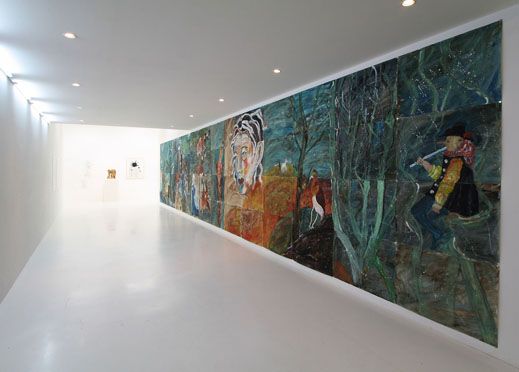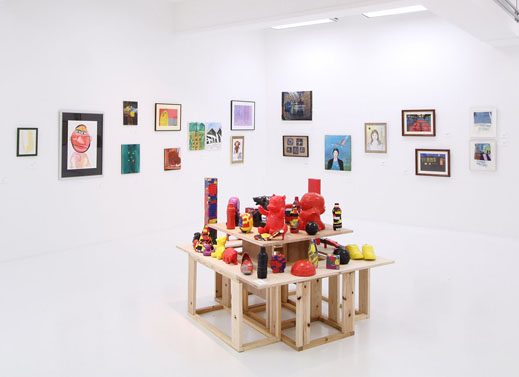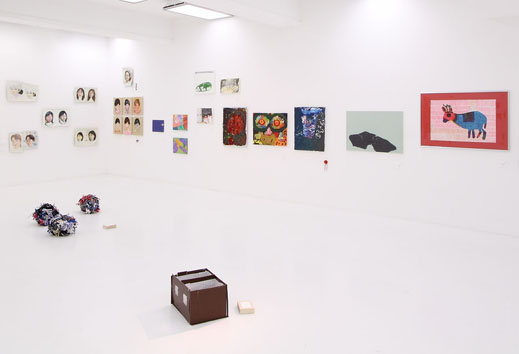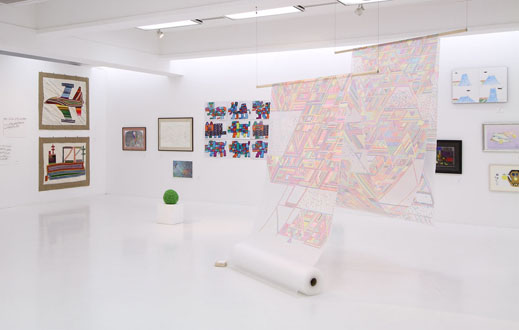 |
|
Focus features two in-depth reviews each month of fine art, architecture and design exhibitions and events at art museums, galleries and alternative spaces around Japan. The contributors are non-Japanese art critics living in Japan.
|
|
|
 |
 |
 |
Come Together: The 3rd Pocorart Exhibition at 3331 Arts Chiyoda
Roger McDonald |
 |
 |
Mitsutaka Tanimoto, Ou no Tabiji, long 10-meter painting work
|
When I was asked to be a judge in the recent Pocorart exhibition, I felt somewhat lost. The reason I felt this way was the nature and scope of the show, which takes in pretty much any form of creative expression. Pocorart takes a particularly inclusive approach to who is defined as an "artist." Launched three years ago by Tokyo's 3331 Arts Chiyoda as a nationwide open-call exhibition, the Pocorart initiative actively expands the definition of who an artist may be by calling on anyone who makes art to apply and send works in for consideration -- from young children to so-called "outsider" artists who may live in psychiatric wards or care homes, old aged pensioners, art students, and hobby painters. The English website states its case thus: "This exhibition reaches beyond pre-established systems, making no distinction between disability or non-disability, age, [or] exhibition history, instead hoping to open a space to encounter human expression and creativity." This makes Pocorart a unique and extremely dense show. It also makes for an exhibition that is unusually passionate in the current context of much contemporary art practice that tends toward conceptual, critical, or photo-video-based work. The palpable energy of Pocorart is something closer to the whole body, rather than just the eye or the mind. At least, this was my overwhelming first impression.
 |
Mai Takehashi, Hatteru Kanji, gum-tape centered work
|
The third and latest edition of the event, which took place from 14 December 2012 to 20 January 2013, featured 214 selected artworks as well as four workshops, which were also selected for realization. Most of the works on display were drawings or paintings. From my knowledge of outsider art, I recognized a number of common approaches or modes, such as intensive scribblings covering the entire paper surface, or endlessly repeated motifs. There were knitted objects, carefully wrapped or layered objects, a number of works using words and language in a frenzied, diaristic way, works using overt religious symbols or narratives, highly expressionistic colored paintings, slightly warped portraits, hazy landscapes, and anime- or otaku-inspired pictures. The exhibition was well installed and generated a highly charged, physical sense of engagement with the works. Pocorart made me rediscover a way of being with art that is not reliant solely on shared insider art knowledge or theory: it presented itself as something infinitely more complex, fascinating, and ultimately strange. For me, this sense of strange-ness is so important -- not in a freak-show sense, but as a marker to look at something that remains beyond comfortable knowing.
 |
Laximi Das Madhaya, Mizu no Oto, Roger's Prize-winning work
|
This kind of non-discriminatory approach to producing art exhibitions can also be seen in similar projects such as the London-based Museum of Everything, which was founded from a private collection of outsider art. In Japan several exhibitions, museums, and initiatives have also emerged in the past five years around art brut -- art made by people with some form of disability or within some welfare-institutional framework. A highly publicized exhibition of Japanese art brut toured to Paris some years ago, propelling interest and further research into this hitherto "hidden" art history. This is a good thing, and Pocorart has taken a leading role in supporting this newly emerging field. But I am also aware that as this kind of art becomes increasingly visible and known, it will invariably develop its own institutional structures, markets, systems of judgment, and audiences. Rather than build a new set of walls, I hope that Pocorart and other initiatives can maintain a sense of true open-ness to the wonderful richness and plurality of art being made by all kinds of people in Japan. The "established" art world too, I hope, will allow for this while acknowledging many histories of art and streams of aesthetic thinking.
 |
Noriko Higashimoto, Untitled
Photography by Kei Miyajima |
 |
 |
Roger McDonald
Roger McDonald was born and brought up in Tokyo, educated in the UK, and returned to live in Japan in 2000 after completing his PhD. He has worked on the Yokohama Triennale 2001 as assistant curator, the Singapore Biennale 2006 as curator, and organised a number of exhibitions and projects independently. He teaches at Tokyo Zokei Art University and Joshibi Art University. He is the founding Director of Fenberger House in Nagano prefecture, a small private house museum.
fenbergerhouse.com |
|
 |
|